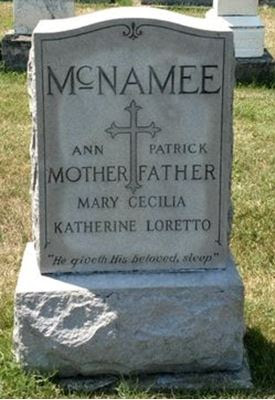Hewson Peeke wrote in A Standard History of Erie County
(Lewis Publishing, 1916) that Vincent Kerber finished construction of the
Whisky Run sewer in 1875. This sewer line ran along Mills Street from the
railroad track to the Sandusky Bay. The walls were fifteen feet high. . (You can see the approximate location of the
Whiskey Run sewer at the rose colored pigmentation along Mills Street on the
map above.)
After Sandusky experienced cholera epidemics in 1849, 1852, and 1854, the English physician John Snow discovered in 1854 that the cause of the spread of cholera was due to the contaminated water supply in wells. In 1876, after much debate, Sandusky constructed a large water works plant that began filtering and pumping water to most homes and businesses in the city.
While conducting maintenance on the Whiskey Run sewer in June of 1876, workers Patrick
McNamee and John Randolph were seriously injured in an explosion. Patrick
McNamee died from his injuries on June 14, 1876. He was buried at St. Joseph’s
Cemetery, not far from the site of the dreadful accident.
When there was a leak in the old Whiskey Run sewer, an article by Charlie Lewis in the September 16, 1972 issue of the Sandusky Register gave some historical speculation about the sewer. It is said to have been a hiding place of whiskey runners during Prohibition -- but even if the story is true, it would not explain the name, which had been in use since at least 1862. The location of nearby breweries and wineries, whose waste products emptied into the Whiskey Run sewer, may have been a possible reason for its name, but even that is pure speculation. It is not unusual for the source of a place name to be forgotten.
A monument at the St. Mary’s Cemetery, which honors the memory of the daughters of Vincent Kerber, overlooks Mills Street, under which the Whiskey Run sewer once flowed.

 this blog
this blog









No comments:
Post a Comment